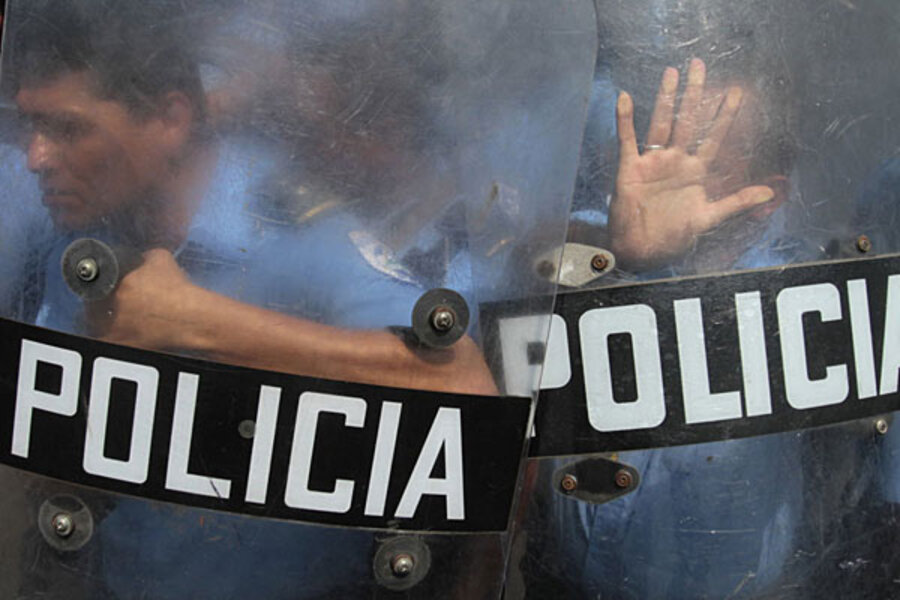Eyeing Middle East, Nicaragua's Ortega quashes weekend protests
| Managua, Nicaragua
Tens of thousands of government supporters occupied the streets of Nicaragua’s capital city this weekend to prevent an opposition march against President Daniel Ortega’s counter-constitutional reelection bid.
The government’s choreographed and coercive demonstration – which included thousands of state workers required to camp out overnight in the streets and public high school students forced to attend Saturday’s rally at risk of receiving grade-point reductions – was hastily organized in the past week to dwarf an anti-Ortega protest that ended up drawing fewer than 2,000 people after heavily armed riot police blocked their ability to march.
“Far from having a professional police force, we have a police force that is at the service of Orteguismo,” said Gonzalo Carrión, of the Nicaraguan Center for Human Rights, shortly before being detained and carried off by police officers. “Today Nicaragua loses, the police lose and Ortega loses, because history will not absolve him.”
At the moment, however, Ortega appears mostly concerned with current events, especially the popular uprisings against authoritarian regimes in the Middle East and how those might inspire a growing number of Nicaraguans fed up with his steady moves to roll back the country's democratic gains in order to consolidate his own power.
Analysts, opposition leaders, and former Ortega allies say the president’s massive mobilization of government workers and Sandinista supporters – plus the deployment of 11,000 police officers to shutdown the city and restrict people’s movement – is a sign that Ortega’s fear of rebellion is bordering on paranoia.
“What we have seen in Northern Africa and the Middle East is that citizen mobilizations can overthrow despotic and authoritarian regimes. And what we saw during [Saturday’s] march was a reflection of the fear and psychosis that has awakened in Ortega’s head as a result of what he’s seeing in that part of the world,” says opposition lawmaker and Sandinista dissident Mónica Baltodano, who was violently dragged away from the protest and tossed on the ground by police.
A wave of discontent
Since recent uprisings that ousted leaders in Egypt and Tunisia – and the efforts by Nicaragua’s opposition to tap into the wave of change those events have had on other countries in that region – President Ortega has demonstrated even more intolerance and levels of heightened suspicion than usual.
In addition to trying to block or counter all forms of protest – including a “virtual Facebook march” organized against his reelection bid last month – the president has also expanded the security perimeter around his family compound, which is now entirely isolated from the rest of the Managua neighborhood.
The massive deployment of police to block yesterday’s relatively small opposition march is another indication of Ortega’s insecurity, opposition leaders insist.
“This demonstrates the fear that Daniel Ortega has of the Nicaraguan people,” feminist leader and march organizer Azalia Solís said in a street interview, shouting over the bursts of homemade explosives shot in the air by protesters.
In a strange way, Ms. Solís says, the government’s full-mobilization response, which cost an estimated hundreds of thousands of dollars to rent buses, print T-shirts and signs, erect stages in the street, and put on a rock concert, turned out to be an unexpected victory of sorts for the opposition.
“The reaction by the government and the fear that they showed of a small group of Nicaraguans is a great success," says Solís. "It shows the ruling party is not as all-powerful as they think they are; their situation of power is very fragile and precarious.”
Peace and love, by presidential order
The Sandinistas’ “March and Festival for Love, Peace and Life” was ostensibly organized by the Sandinista Youth movement, although first lady Rosario Murillo’s strong and quirky influence over the event was palpable.
The event, organized on a week’s notice, was quickly backed by other government-affiliated unions and state institutions.
With faces painted with peace signs and dressed in government-issued T-shirts that screamed peace and love, the Sandinistas occupied the major downtown crossing – the same spot the opposition had picked as the starting point for its march.
The Sandinistas held a variety of signs with messages alluding to peace, condemning the coalition attacks against Col. Muammar Qaddafi's forces in Libya, and defending Ortega’s reelection bid, which is prohibited by Article 147 of the Constitution.
Though the police had initially approved the opposition’s march route and agreed to provide protection, they ultimately prevented the march from happening after the Sandinistas preemptively occupied the streets. Police Chief Aminta Granera defended the police’s action in blocking the march, saying their job was to prevent bloodshed by keeping the two groups separated.
But to many in the opposition, it appeared as if the police were giving preferential option to the Sandinista demonstration. Indeed, while the Sandinistas were allowed to move freely through police barricades, the opposition and common citizens were stopped, redirected around the center of town, and denied access to whole sections of the city.
“The turnout to our march hasn’t been sufficiently large, but that’s because Daniel Ortega is fearful and has done everything possible to impede participation," says Sandinista dissident Moisés Hassan, one of the original five members of the Sandinista revolutionary junta in the 1980s. "The people who are here had to walk long distances, jump over fences, and confront police barricades, but they came against the current and despite the threats.”
Despite the relatively low turnout, Mr. Hassan said the opposition march was a sign of what’s to come as the November presidential election approaches. The former revolutionary leader says he thinks the answer to Nicaragua’s institutional and political crisis will have to be resolved in the streets.
Hassan says if the opposition’s initial effort to prevent “Ortega’s illegal candidacy” fails to keep the president from remaining in power beyond 2011, there will come a “second struggle to remove him from a false presidency.”





